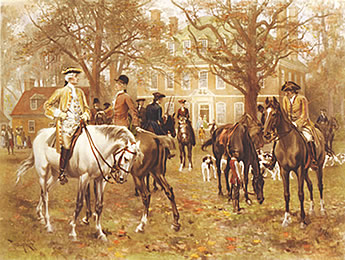IV.  Bibliography
Bibliography
Andrews, Charles McLean. The Colonial Period of American History. New Haven: Yale University Press, 1934.
———. Colonial Self Government 1652–1689. New York: Harper Brothers, 1904.
Beer, George Davis. The Old Colonial System 1660–1754. New York: MacMillan, 1912.
Beverly, Robert. The History and Present State of Virginia. Charlottesville: University Press of Virginia, 1947.
Billings, Warren M., ed. The Papers of Sir William Berkeley 1605-1677. Richmond, VA: Library of Virginia,
2007. http://www.uno.edu/~history/berkeley.htm.
———. “Sir William Berkeley.” Virtual Jamestown, Jamestown Interpretive Essays. http://www.virtualjamestown.org/essays/billings_essay.html.
———. Sir William Berkeley and the Forging of Colonial Virginia. Baton Rouge: Louisiana State University
Press, 1965.
Bond, Beverly W. The Quitrent System in the American Colonies. New Haven: Yale University Press, 1919.
Bruce, Philip A. Institutional History of Virginia. New York: P. G. Putnam, 1910.
Charters of the Virginia Company of London; Laws, Abstracts of Rolls in the Office of State. Vol. 6. Virginia
Manuscripts, 1607–1737. “Thomas Jefferson Papers Series 8.” Washington, DC: Library of Congress.
Churchill, Winston. A History of the English Speaking Peoples. Vol. 2. New York: Dodd, Mead, & Company, 1956.
Dabney, Virginius. Virginia, The New Dominion. Charlottesville: University Press of Virginia, 1971.
Dunstan, Effie Crittenden. “Colonial Alexandria 1749–1776: The Governmental Power Structure,” in A
Composite History of Alexandria. Alexandria, VA: Alexandria Bicentennial Commission, 1975.
Fiske, John. Historical Writings: Vol. 4, Old Virginia and Her Neighbors. Standard Library Edition. Cambridge, MA: Riverside Press, 1902.
Fraser, Antonia. Royal Charles - Charles II and the Restoration. New York: Dell Publishing, Delta Book, 1979.
Great Britain. Board of Trade. Journal of the Commissioners for Trade and Plantations. London: Public Record
Office, 1938.
Great Britain. Public Record Office. Calendar of State Papers: Colonial Series, America and West Indies, 1574. By Sir John William Fortescue. London, 1928.
Haile, Edward Wright, ed. Jamestown Narratives: Eyewitness Accounts of the Virginia Colony (The First
Decade: 1606-1617). Champlain, VA: RoundHouse, 1998.
Hamor, Ralphe. A True Discourse on the Present Estate of Virginia, and the Successe of the Affaires There
until the 18 of June 1614. The Capital and the Bay: Narratives of Washington and the Chesapeake Bay Region, ca. 1600-1925. Washington, DC: Library of Congress. Published by Albany J. Munsell, 1860. Call Number: F229.H19. Digital ID: lhbcb 02778.
Harrison, Fairfax. The Proprietors of the Northern Neck: Chapters of Culpeper Genealogy. N.p.: n.p.,1926;
Culpepper Connection! The Culpepper Family History Site. http://www.gen.culpepper.com/historical/
nneck/5a-leeds.htm.
———. Virginia Land Grants: A Study of Conveyancing in Relation to Colonial Politics. Westminster, MD: Heritage Books reprint, 2007.
Hendrick, Burton. The Lees of Virginia: Biography of a Family. Boston: Little Brown, 1935.
Hobbes, Thomas. Leviathan. New York: Penguin Classics, 1985.
Isaac, Rhys. The Transformation of Virginia, 1740–1790. Chapel Hill: Omohundro Institute of Early American
History and Culture, University of North Carolina Press, 1999.
Jordan, Don, and Michael Welsh. White Cargo: The Forgotten History of Britain’s White Slaves in America.
New York: New York University Press, 2008.
Journal of the House of Burgesses of Virginia 1619–1658/9. Edited by H. R. McIlwaine, Richmond, VA: n.p.,
1915.
Journal of the Continental Library of Congress. “The Declaration of Rights and Grievances” Washington,
DC: Government Printing Office, 1904.
Kammen, Michael. Deputyes and Libertyes: The Origins of Representative Government in Colonial America.
New York: Alfred A. Knopf, 1969.
Kupperman, Karen Ordahl, ed., Captain John Smith: A Select Edition of His Writings. Chapel Hill, NC:
University of North Carolina Press, 1988.
Library of Congress. Colonial Settlement, 1600s–1763. “Implementing the Great Charter in Virginia, 1619.” http://www.loc.gov/teachers/classroommaterials/presentationsandactivities/presentations/timeline/
colonial/virginia/charter.html.
Locke, John. Two Treatises of of Government. Edited by Peter Laslett. Cambridge, England: Cambridge
University Press, Paperback edition, 1991.
Morgan, Edmund. American Slavery - American Freedom. New York: W. W. Norton, 1975.
Morton, Richard L. Colonial Virginia, Vol. 1. Chapel Hill, NC: University of North Carolina Press, 1960.
Osgood, Herbert L. The American Colonies in the Seventeenth Century. Vol. 3. New York: Columbia University Press, 1904-1907.
Parkinson, Andrew. “Sir Edwin Sandys.” Northbourne Sources, biographical information. http://freespace.virgin.net/andrew.parkinson4/san_intr.html.
Peterson, Merrill, ed. The Writings of Thomas Jefferson. New York: Library of America, 1984.
The Records of the Virginia Company of London. Vols. 1-4. Bowie, MD: Heritage Books, 1999. Edited by Susan Myra Kingsbury.
The Records of the Virginia Company, 1606-1627. Vol. 3. “Thomas Jefferson Papers Series 8.” Virginia Manuscripts, 1607-1737. Washington, DC: Library of Congress. Miscellaneous Records.
Robinson, W. Stitt. Mother Earth Land Grants in Virginia 1607–1699. Williamsburg, VA: Virginia 350th Anniversary Celebration Corporation, 1957.
Rubin, Louis. Virginia, A History. New York: W. W. Norton, 1984.
Sutton, Robert P. Revolution to Succession. Charlottesville, VA: University Press of Virginia, 1989.
Thorpe, Francis Newton, ed. The Federal and State Constitutions Colonial Charters, and Other Organic Laws
of the States, Territories, and Colonies Now or Heretofore Forming the United States of America. Compiled and edited under the Act of Congress of June 30, 1906. Washington, DC: Government Printing Office, 1909.
Washburn, Wilcomb. Virginia under Charles I and Cromwell, 1625-1660. Williamsburg, VA: Virginia 350th
Anniversary Celebration Corporation, 195.rew
Wertebnbaker, Thomas J. Bacon’s Rebellion, 1676. Williamsburg, VA: Virginia 350th .



